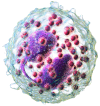Eosinophils in Oral Disease: A Narrative Review
- PMID: 38673958
- PMCID: PMC11050291
- DOI: 10.3390/ijms25084373
Eosinophils in Oral Disease: A Narrative Review
Abstract
The prevalence of diseases characterised by eosinophilia is on the rise, emphasising the importance of understanding the role of eosinophils in these conditions. Eosinophils are a subset of granulocytes that contribute to the body's defence against bacterial, viral, and parasitic infections, but they are also implicated in haemostatic processes, including immunoregulation and allergic reactions. They contain cytoplasmic granules which can be selectively mobilised and secrete specific proteins, including chemokines, cytokines, enzymes, extracellular matrix, and growth factors. There are multiple biological and emerging functions of these specialised immune cells, including cancer surveillance, tissue remodelling and development. Several oral diseases, including oral cancer, are associated with either tissue or blood eosinophilia; however, their exact mechanism of action in the pathogenesis of these diseases remains unclear. This review presents a comprehensive synopsis of the most recent literature for both clinicians and scientists in relation to eosinophils and oral diseases and reveals a significant knowledge gap in this area of research.
Keywords: eosinophils; oral cancer; oral diseases; oral potentially malignant disorders.
Conflict of interest statement
The authors declare no conflicts of interest.
Figures








References
-
- Ehrlich P. Uber die Specifischen Granulation des Blutes. Archiv fur Anatomie und Physiologie. Leipzig, Veit & Company; Leipzig, Germany: 1879. Physiologische Abteilung.
-
- Saraswathi T., Nalinkumar S., Ranganathan K., Umadevi R., Elizabeth J. Eosinophils in health and disease: An overview. J. Oral Maxillofac. Pathol. 2003;7:31–33.
-
- Wardlaw A.J., Moqbel R., Kay A.B. Eosinophils: Biology and role in disease. Adv. Immunol. 1995;60:151–266. - PubMed
Publication types
MeSH terms
Substances
LinkOut - more resources
Full Text Sources
Medical
Miscellaneous

